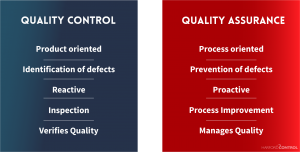Editorials
Combining QC, QA and error-proofing to improve quality
The difference between Quality Control and Quality Assurance
Even now, these two terms are often used interchangeably by manufacturing professionals, despite being quite different in their essence. However, it is easy to get confused with all the terminology. Therefore, we aim to provide some clarification to enable manufacturers to achieve significant success in 2021, with reduced waste, less risk and improved productivity – it all starts with the approach to quality.
Quality Control
The ASQ/ISO 9001:2015 defines Quality Control as “part of quality management focused on fulfilling quality requirements.” QC is focused on the end product, aiming to make sure it meets the expectations by identifying defects.
Quality Control is a reactive approach, aiming to find already existing defects through inspection and testing. This way, QC can provide the QA team with feedback to guide the direction they work in to minimise defects.
Quality Assurance
Quality Assurance is defined as “part of quality management focused on providing confidence that quality requirements will be fulfilled.” QA is focused on the process, ensuring that all activities will result in products meeting the expectations in the first place, preventing defects.
Quality Assurance is a proactive approach, aiming to prevent issues before they affect a product. Via documentation, planning, auditing, and training, QA intends to increase productivity, prevent issues, and optimise the processes to remove issues and avoid them happening again.
Quality Control and Quality Assurance are not mutually exclusive, both are important elements of quality management.
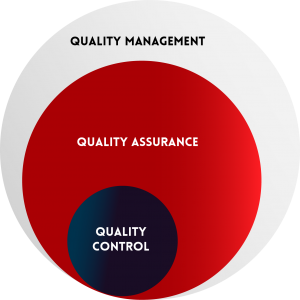
Quality assurance is focused on primary production, whereas QC takes secondary inputs into account. In a food production scenario, QA would be responsible for ensuring that the food is cooked properly, and QC would check whether it has been contaminated by bacteria, chemicals, or packaged incorrectly.
Quality Improvement
Quality Improvement is somewhat similar to QA, as it also considers the bigger picture and takes action to remove issues. However, they utilise different methodologies: while QA is theoretical, Quality Improvement is more action-driven, combining inspection results with proactive prevention.
Which approach should I take?
Paper vs. paperless
Key for any quality approach is accurate data. The way quality data is captured influences the accuracy of information that becomes available to the quality team, no matter which approach they take.
Flexible and convenient as it may be, paper has a range of limitations, especially in a manufacturing quality data capture context. There are three major problems associated with paper: cost, time, and risk. Next to the physical cost of paper, ink, and storage, a lot of time is wasted manually duplicating data across sheets, collating the sheets, transcribing the results into a spreadsheet, and further analysis. Risk comes in the form of loss, damage or decay, though the primary issue is the human element, which often introduces inaccuracies like typos, poor legibility, or wrong time stamps as well as, occasionally, falsification.
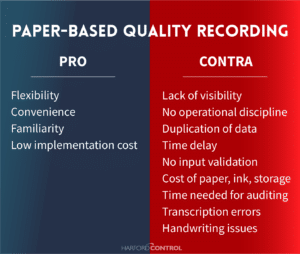
Paperless benefits
Therefore, the only way to ensure the availability of accurate data in manufacturing is using a paperless approach. This way, entered data can be compared against the expected results based on the specification in real-time, providing operators with feedback or corrective action guidance right away. With an appropriate system behind it, real-time visibility of quality problems can be achieved across a whole business with simple email notifications, reporting tools and large screen dashboards.
Going paperless provides a few other benefits, such as reduced duplication of data entry, increased operational discipline through alerts when inspections are due, a standardised approach to testing (incl. visual guidance with images and videos), full accountability with electronic signatures, but most importantly, it frees up operators to focus on their actual job instead of performing clerical tasks. Complexity can be reduced on opposite ends, by having an easy-to-use approach to capturing data, which feeds into instant reporting with endless options for viewing, trending and accessing information. Instead of taking hours to collate the right sheets for an audit, all information is available at the click of a button.
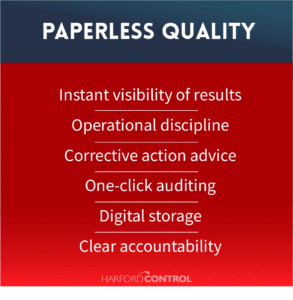
QC, QA, QI?
While QC is focused on the inspection of finished goods using a standardised process, and provides easy reporting of results – exceptions, in particular – QA employs a more informed approach to improving processes and makes use of built-in functions to automatically assess and improve process tolerances. QI, in turn, provides visibility of improvement opportunities, especially of recurring issues and attributes cost and wastage to focus efforts.
Any chosen solution should ideally be able to unite all of these approaches, to reap the combined benefits of having a standardised, paperless approach to quality, with continuous improvement at the heart of it, facilitated by data visibility.
How can I improve quality?
Quality is one key aspect in our approach to helping manufacturers with their Digital Transformation efforts, moving from a paper-based business to a paperless factory – especially on the shopfloor.
Based on the principles of poka-yoke (a Lean Manufacturing tool concerned with mistake-proofing), Harford combines multiple error-proofing techniques to ensure quality. Very briefly, prevention of mistakes is achieved through the automated setup of line equipment, removing the need for human involvement, thus reducing the risk of human error. Employing techniques and combining steps to make work easier to perform, e.g. the use of paperless quality checks with step-by-step guidance and instant feedback, is classed as facilitation. If a mistake still happens, it needs to be identified (detection) before further processing occurs, so that the operator can quickly correct the problem.
These error-proofing concepts loosely align with the different quality approaches outlined above: Quality Control is concerned with detection of defects, Quality Assurance facilitates quality consistency, whereas Quality Improvement looks to eliminate or prevent quality issues.
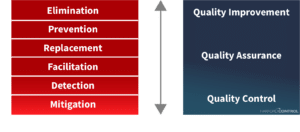
In our efforts to introduce paperless quality management into manufacturing, our primary aim is to make data capture as easy and user-friendly as possible to encourage quick adoption by frontline operators with minimal resistance to change. After all, the quality of data input hugely impacts the quality of information output.
The bigger picture
To remain competitive, most manufacturers are continually looking to make their products better, faster, cheaper – that means improving quality, increasing efficiency, and reducing cost. Paperless quality management done right can impact all three factors. Better quality is achieved through better process control with fewer rejects, whilst the time taken to perform checks manually can be reduced by digitizing data capture, and cost savings are gained through reduced wastage as a result of automated analysis and guidance provided by such a system.
The basic architecture required for such a solution lends itself very well to further automation of processes, capture of line efficiency data, the incorporation of quality results into OEE for an accurate representation of performance, materials traceability, mass balance/yield control, and much more.
“Having now installed the Harford system across all our packing lines, I am very happy with our improvement to date. Through it’s well structured hardware and software routines, it has helped us to minimise production risk, improve quality consistency and improve efficiency, whilst eliminating most factory floor paperwork and providing instant traceability.”
— Richard Fox, Operations Director, Emmett
Find out more about how to ensure product safety and quality compliance with real-time visibility on the shop floor here.
Reach out to our experts for a chat about how you can benefit from removing paper and extending your own approach to quality management!
Share your thoughts to Info@harfordcontrol.com or give us a call on +44 (0) 1225 764461

